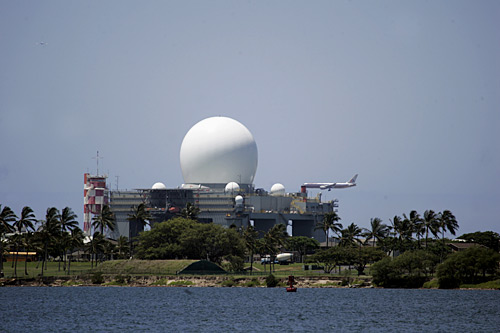Giant sea-based radar undergoes $7M repair

Planes approaching Honolulu Airport seem to be "docked" to the Sea-Based X-Band Radar platform as they fly by it in a photo taken from the Neal Blaisdell Park in Pearl City. The radar was in Hawaii for routine maintenance.
The Missile Defense Agency’s giant floating radar is in for some expensive repairs at Pearl Harbor and later on the West Coast.
The $1 billion ballistic missile tracker, known as the Sea-Based X-Band Radar, or SBX, arrived back at Pearl Harbor on July 13.
The Missile Defense Agency said the 280-foot-tall former oil rig will undergo about $7 million in repairs here.
"SBX will be in port to perform periodic maintenance and to conduct American Bureau of Shipping surveys that will lead to renewal of the SBX U.S. Coast Guard Certificate of Inspection," the agency said. "These include checks of the vessel hull and machinery operating condition and safety, as well as checking all safety programs aboard SBX."
The distinctive radar is expected to be in Hawaii until the fall.
Missile Defense Agency officials also are looking at three deepwater ports on the West Coast for additional maintenance. They are Naval Station Everett, Wash.; Todd Pacific Shipyard in Seattle; and Naval Air Station North Island, San Diego, said Pam Rogers, an agency spokeswoman. Pearl Harbor is not deep enough, she said.
Don't miss out on what's happening!
Stay in touch with breaking news, as it happens, conveniently in your email inbox. It's FREE!
The Seattle Post-Intelligencer said an informational meeting was held in Washington state last week to lay out plans for the SBX’s possible stay there.
The online news site said the manufacturer-recommended, five-year maintenance will be on the platform’s thrusters and also will include painting and system upgrades at an estimated cost of about $9.4 million.
The powerful radar has 45,000 radiating elements within its white pressurized dome to track targets. Designed to discriminate nuclear warheads from decoys, the radar is so powerful it can detect a baseball flying through the air on the East Coast when the SBX itself is on the West Coast.
Adak, Alaska, was the radar’s intended home port, but the SBX has spent scant time there. It has never pulled into port in Adak, officials said.
In a letter to the agency in 2006, Rear Adm. James Olson, commander of the Coast Guard district around Alaska, said operations in the Bering Sea are inherently dangerous, with winds of 80 knots (92 mph) and gusts of more than 120 knots (138 mph) and sea states in the SBX operations area exceeding 30 feet.
"I urge you to consider safety as your first priority in this hostile environment," Olson said, adding that he believed the SBX was not capable of "maintaining station."
The radar platform is large enough to fit 18 basketball courts.
In 2003, Pearl Harbor and Kalaeloa were considered as home port possibilities for the SBX, along with anchorages in California, Washington state, the Marshall Islands and two sites in Alaska, before Adak was selected.
Since the "golf ball" arrived here in 2006 from Corpus Christi, Texas, for a temporary stay, it has returned periodically to Hawaii for millions of dollars in maintenance and repairs.
The SBX last left Pearl Harbor on June 16, 2009.
According to the Missile Defense Agency, the vessel traveled around the central Pacific within a thousand miles of Hawaii, and was in the northern Pacific near Adak, and the Bering Sea north of Dutch Harbor. But the SBX did not dock in Adak.



